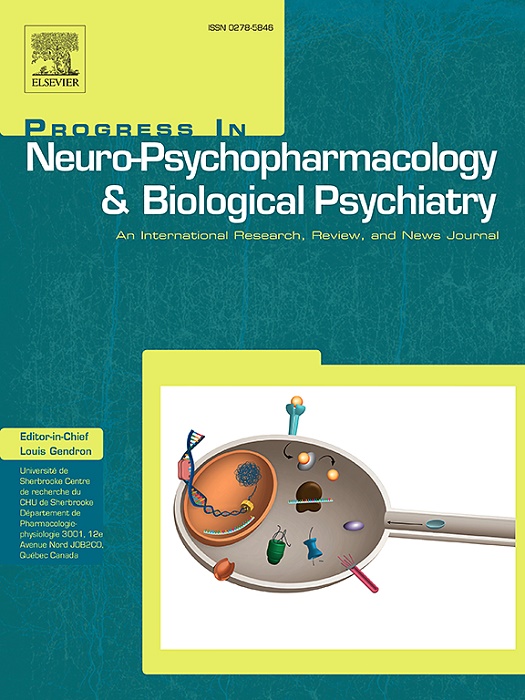treatment-naïve早期成人重度抑郁症患者与健康对照者儿童虐待相关皮质结构差异
IF 3.9
2区 医学
Q1 CLINICAL NEUROLOGY
Progress in Neuro-Psychopharmacology & Biological Psychiatry
Pub Date : 2025-09-09
DOI:10.1016/j.pnpbp.2025.111488
引用次数: 0
摘要
目的:儿童虐待(CM)是已知的重度抑郁障碍(MDD)的危险因素,并显著影响大脑结构,尽管值得注意的是,一些创伤暴露的个体随后并未发展为临床抑郁症。本研究探讨CM和MDD对早期成人大脑皮层形态的交互作用。方法:本研究采用2 (MDD vs.健康对照) × 2 (CM:是vs.否)与顶点方向的一般线性模型来研究不同诊断组CM对皮质形态学的神经解剖学差异影响。互补兴趣区(ROI)分析主要集中在内侧前额叶皮层,因为它在情绪应激加工和调节中起着既定的作用。结果:全脑顶点分析显示,在MDD组中,有CM病史的个体与没有CM的个体相比,双侧楔前叶体积和左楔厚度显着减少。相反,在HC组中,CM个体显示双侧楔前叶皮质体积和左侧楔厚增加。ROI分析显示cm暴露的HC的cACC厚度增加,而MDD患者的cACC厚度减少。HC组左侧楔前叶厚度与身体忽视、左侧楔前叶体积与情绪忽视、右侧楔前叶体积与性虐待呈显著正相关。MDD组右侧楔前叶体积与病程呈显著负相关。结论:这些发现表明CM会导致重度抑郁症患者的皮质异常,而HC可能对早期逆境表现出神经适应性反应,从而确定CM后对重度抑郁症的易感性或恢复力的潜在神经生物学标志物。本文章由计算机程序翻译,如有差异,请以英文原文为准。
Childhood maltreatment-related cortical structural differences between treatment-naïve early adults with major depressive disorder and healthy controls
Objectives
Childhood maltreatment (CM) is a known risk factor for major depressive disorder (MDD) and significantly impacts brain structure, although it is noteworthy that some trauma-exposed individuals do not subsequently develop clinical depression. This study investigates the interaction effects of CM and MDD on morphology of cerebral cortex in early adults.
Methods
This study employed a 2 (MDD vs. Healthy controls) × 2 (CM: Yes vs. No) with vertex-wise general linear models to investigate differential neuroanatomical effects of CM on cortical morphology across diagnostic groups. Complementary region-of-interest (ROI) analyses focused on the medial prefrontal cortex given its established role in emotional stress processing and regulation.
Results
Whole-brain vertex-wise analysis revealed that in the MDD group, individuals with a history of CM exhibited significantly reduced bilateral precuneus volume and left cuneus thickness compared to those without CM. Conversely, in the HC group, individuals with CM showed increased bilateral precuneus cortical volume and left cuneus thickness. ROI analysis showed CM-exposed HC had greater cACC thickness, whereas MDD patients exhibited reduced trends. In the HC group, significant positive correlations emerged between left cuneus thickness and physical neglect, left precuneus volume and emotional neglect, and right precuneus volume and sexual abuse. In the MDD group, a significant negative correlation was found between right precuneus volume and disease course.
Conclusion
These findings suggest that CM induces cortical abnormalities in individuals with MDD, whereas HC may demonstrate neuroadaptive responses to early adversity, identifying potential neurobiological markers of vulnerability or resilience to MDD following CM.
求助全文
通过发布文献求助,成功后即可免费获取论文全文。
去求助
来源期刊
CiteScore
12.00
自引率
1.80%
发文量
153
审稿时长
56 days
期刊介绍:
Progress in Neuro-Psychopharmacology & Biological Psychiatry is an international and multidisciplinary journal which aims to ensure the rapid publication of authoritative reviews and research papers dealing with experimental and clinical aspects of neuro-psychopharmacology and biological psychiatry. Issues of the journal are regularly devoted wholly in or in part to a topical subject.
Progress in Neuro-Psychopharmacology & Biological Psychiatry does not publish work on the actions of biological extracts unless the pharmacological active molecular substrate and/or specific receptor binding properties of the extract compounds are elucidated.

 求助内容:
求助内容: 应助结果提醒方式:
应助结果提醒方式:


